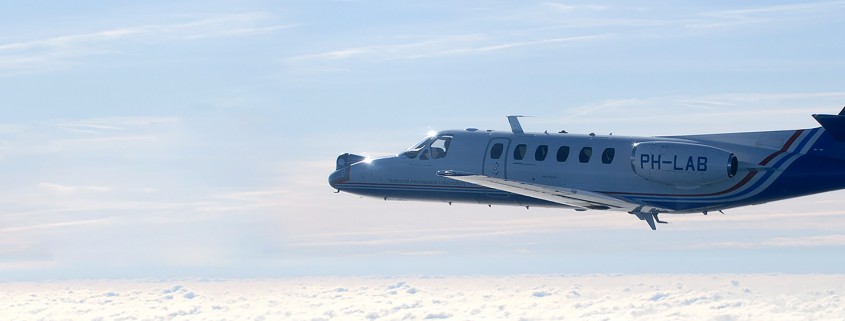It’s far from unknown for peak crowding at airports to hit the headlines. And it’s not only the passengers who are stuck in queues: it’s busy in the air too. That’s why the ITARO project has bundled various solutions together to reduce the delays for flights, including gains that can be made in terms of noise nuisance and emissions. The European SESAR2020 project ITARO (PJ.37) has recently been completed. Previous SESAR studies showed that individual solutions in the airport surroundings could yield both operational and ecological efficiency improvements. To make sure that the desired results were also obtained when these were used in combination, ITARO has been integrating all those individual solutions into an operational concept. Demonstrations have shown that this does indeed lead to more efficient and more integrated flows of aircraft as they approach the airport. An optimised and cohesive combination of good planning, accurate predictability and clear air traffic operations can in fact lead to fewer delays, which improves the landing and departure operations. This is also expected to be beneficial for the surroundings because there will then be less noise nuisance in the general area. There will also be lower emissions, as fixed routes will be used and less engine power required for the flights. Simulations It involves combining fixed approach paths with a continuous descent (Continuous Descent Operations or CDOs) plus Interval Management (IM). The latter is a technology in which the aircraft, after receiving instructions from air traffic control, autonomously flies to a specifically instructed routing point at a stated distance (or time interval) behind the aircraft in front and then maintains that distance (or interval). Additional buffer zones between the approaching craft, which are needed nowadays when operating fixed approach paths in combination with CDOs, then become redundant. One of the effects of those buffers is that delays are introduced when capacity requirements are highest, at peak times. That is why the combination of fixed approach routes with CDOs during daytime peaks is not yet used at Schiphol, even though such solutions have demonstrable environmental benefits. “The air traffic controllers get extra visual support at their workplace for this,” explains the project lead, Nico de Gelder (NLR). “It tells them the best way of keeping successive aircraft apart as they approach the airport, without compromising safety. With that additional information, they’re able to deal with the peaks well, even when fixed approach routes are being used in combination with CDOs.” In addition to simulated approaches, simulations have also been done for departing traffic using APERO, NLR’s cockpit flight simulator. The focus there was primarily on new cockpit technology that would give a picture earlier, at route points where climbing and descending traffic regularly crosses, of whether a potential infringement of separation (lack of distance between the aircraft) could occur at the crossover point. The technology will result in improved traffic flow solutions because such an overview can be produced earlier on and action can be taken, meaning that less traffic will have to be taken off those routes. Flights with PH-LAB Follow-up
The project has integrated four operations solutions and used real-time solutions to demonstrate them in NARSIM, the NLR simulation environment for air traffic controllers and pilots, which uses realistic scenarios for the approaches to Schiphol.
In addition to the simulations, the project also carried out real-world test flights in an operational environment at Groningen Airport Eelde. Those flights were carried out with the Cessna Citation II research plane belonging to NLR/TU Delft, in collaboration with DLR and their ISTAR-Falcon 2000LX aircraft. As part of this, working with Honeywell, the specially developed Flightdeck Interval Management cockpit systems were built into the NLR aeroplane and special (ADS-B-IN) antennas were fitted to it too. With the DLR aircraft in the leading position and this new system on board the following NLR plane, the two aircraft flew various scenarios to allow the instructed distance between them (time interval) to be maintained better during the approach to the airfield. These flights were carried out using specially designated fixed approach paths from approximately flight level 140 and with special CDO profiles descending to the airport. Scenarios were tested not only in which the two planes were one directly behind the other but also in which they approached from different directions. This all worked very well, in a variety of weather conditions. The onboard IM system positioned the (NLR) aircraft at the targeted routing point to within a few seconds, at the desired distance (time interval) behind the DLR plane. All this, in particular the IM system, made it possible to plan the arrivals of the planes near the landing runway very effectively.
The aim of ITARO (Integrated TMA, Airport and Runway Operations) is to achieve accelerated implementation in the near future and to maximise the network performance by combining solutions that will make aviation greener.
“What we have learned here will let SESAR look further,” says Royal NLR’s PJ.37-ITARO project coordinator, Wilfred Rouwhorst (NLR). “The actual implementation of these ITARO improvements will optimise the flow of air traffic. It’s the combination of fixed approach paths with CDOs while maintaining capacity, thanks to IM, that is letting us take yet another step towards reduced climate impact and noise nuisance for local residents.”
Would you like to know more?
Take a look here for more information about safe and competitive operations.


